
© Railway Wonders of the World 2012-


Poland’s Main Lines
A New Country Creates an Important Railway System
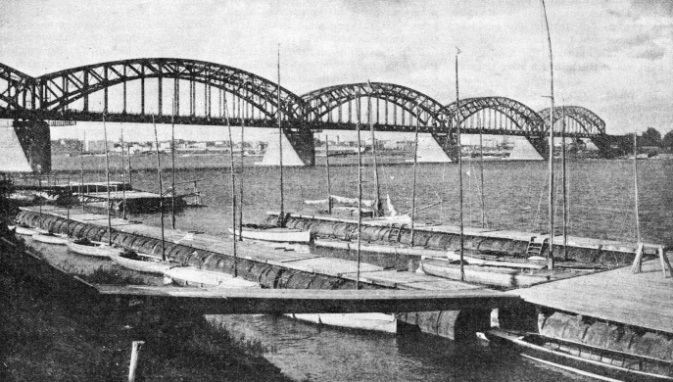
A RAILWAY BRIDGE IN WARSAW that was opened to traffic in 1931. Warsaw, the capital of Poland, stands on the left bank of the Vistula, and is the grand junction for international routes linking up Moscow, Vienna and Berlin. In the vicinity of the capital there has been an extensive electrification of lines.
NO country has had to face such a gigantic task of railway reconstruction within the last decade as the republic of Poland. Although Warsaw, the capital, is only a journey of some twenty-
The area of Poland is about 152,000 square miles, and the population is more than 33,000,000. The country is thus nearly twice the size of Great Britain, and contains about three-
In the past Poland was the prey of her neighbours, and in 1795, after two previous partitions, Russia, Prussia, and Austria divided the whole country among themselves, and thought that they had finally obliterated its existence as a free country. But they reckoned without the Pole. The republic of Poland was proclaimed in November, 1918; independence was guaranteed by the Treaty of Versailles. Thus, after an eclipse of over 120 years, Poland regained her entity as a nation. Her troubles, however, were not yet over, as war broke out with Russia in 1919. After Warsaw had been in imminent danger of surrender, a Polish counter-
The Ministry of Communications, which took over the railways of the new state, was faced with the task of repairing and co-
The Russians had wrecked bridges and other railway works to hamper pursuit as they retreated, and although the Germans, in their advance, had repaired the lines to a degree sufficient for military operations, they were not primarily concerned with the peace needs of the country. The new State, therefore, found the railways in a deplorable condition.
The following figures will give an idea of the havoc that had been wrought in Eastern Poland. There had been destroyed eighty per cent of the bridges, seventy-
The permanent way had suffered less, perhaps, from high explosives than from being left without repair for some four years. Here and there the warring armies had removed miles of track, or had blown up junctions and points. But this damage was not so very great in proportion to the total length of the lines The neglect of worn out rails and the use of rotten sleepers had caused more serious damage, and it was to these factors that the lamentable conditions of the railways after the war were due.
The rolling-
The railway administrators had to work out the best method of resuscitating a system with only a fifth of its bridges intact, with an unsafe track, and with inadequate and dilapidated rolling-
Reconstruction has absorbed most of the funds available, and the work is not yet complete. Twenty-
Both the volume and the direction of the traffic have been radically altered by the changed political and economic conditions of the country, and the building of second tracks or supplementary crossings has become necessary on many lines. This has caused a need for new stations, new supply facilities. and new locomotives. Most of these extensions are wanted mainly on the lines connecting Silesia with the Baltic ports. Much of this work has now been completed.
Extensions in Progress
Another great task was the rearrangement of several big junctions, especially that of Warsaw. The first section of the work at Warsaw has been finished, and the remainder of the work is nearing completion. One part of this large extension work, the electrification of Warsaw Junction, undertaken by a British company, deserves special mention, Work on the electrification of the underground section of the junction and of the suburban lines is in hand. The plans of the extension provide also for the erection of a new central station at Warsaw.
The new standard gauge railway, 320 miles long, from the Silesian coalfield to the Baltic port of Gdynia, which was constructed in 1933, is operated by the French company that built it. The growing traffic at Gdynia demands constant extensions of the railway services and the laying of sidings on which goods wait for shipping.
With the improvements in rolling-
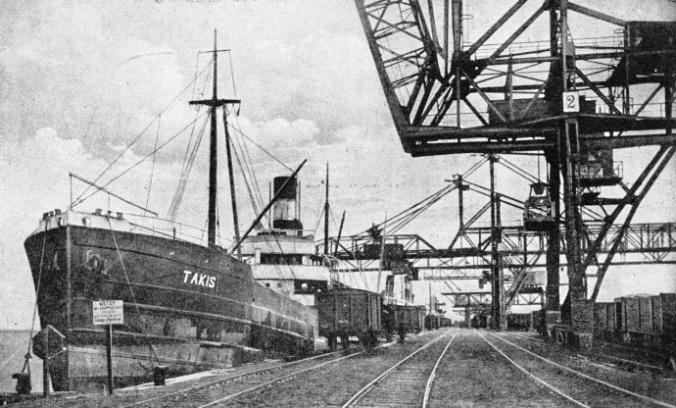
PORT GDYNIA. An important line from the Silesian coalfields connects the mines with this port, which forms a vital exportation outlet. Growing traffic at Gdynia demands a continuous increase of sidings where goods may wait for shipment. The port handles over 5,000,000 tons of freight in a year. The railway from the mines is 320 miles long, and was built in 1933.
The improvements to the rolling-
On some services rail-
After the economic depression of 1932 the Polish railways regained ground, the number of passengers increasing to over 124 millions. The return to prosperity is largely due to the efforts of the administration to adapt the service to the requirements of the public. The “popular” trains are one example of this policy. These trains enable people to explore the whole country at a very cheap rate In one month -
An innovation showing the enterprise of the Ministry of Communications is the “train-
Each compartment accommodated four passengers, and was provided with comfortable beds, which were folded up in the day-
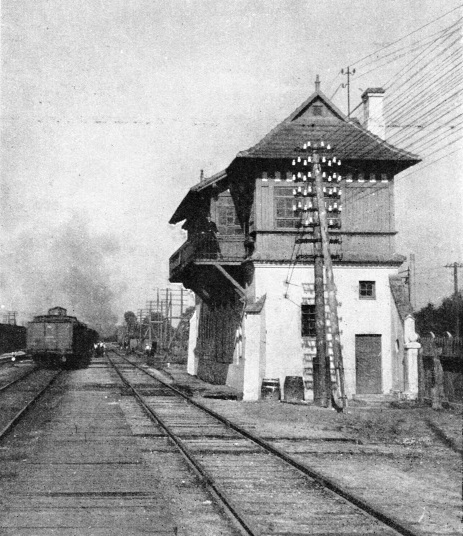
In addition to the restaurant car, the “train-
A SIGNAL BOX at Czestochowa, in southern Poland.
Thanks to its geographical position Poland offers the most natural and direct route across Europe between the Baltic ports of Danzig and Gdynia and the Romanian Black Sea ports. The early trader-
The name Poland -
A small area of the Baltic coastland in the north has slopes rising to some 600 ft; south of this begins the great Polish Plain. Beyond the plain is a region of low plateaux; and in the extreme south is a depression after which rise the northern slopes of the Carpathian Mountains, which the railways are opening up as winter resorts. Thus the countryside is flat and densely populated in the western and central parts, mountainous in the south, and thickly wooded and sparsely populated in the east.
The territory known as the Polish Corridor, which separates East Prussia from the rest of Germany, is interesting to the railway enthusiast. Trains from Western Germany to East Prussia are hauled across Polish territory by Polish locomotives. The weight of these trains has increased to such an extent that new locomotives, the most powerful in Poland, have been made in Polish workshops and put into service.
 The city of Danzig was made a free port under the Peace Treaty, and the lines round it were taken over by Poland in 1920. But, to provide an outlet for the export of Silesian coal, a new railway, keeping entirely within Polish territory, was built, and a new port was con-
The city of Danzig was made a free port under the Peace Treaty, and the lines round it were taken over by Poland in 1920. But, to provide an outlet for the export of Silesian coal, a new railway, keeping entirely within Polish territory, was built, and a new port was con-
INDUSTRIAL POLAND has realized the supreme importance of a good railway system. The upper photograph shows a blast-
In 1919 Gdynia was a fishing village of 1,200 inhabitants, with some attractions as a seaside resort. In 1924 the authorities decided to make it a port, with the result that the population had increased to 50,000 by 1931, and has grown rapidly since.
The network of railways in the provinces of Pomorze and Poznan, which constitute north-
The line from Warsaw to Poznan and Zbaszyn forms part of the Warsaw-
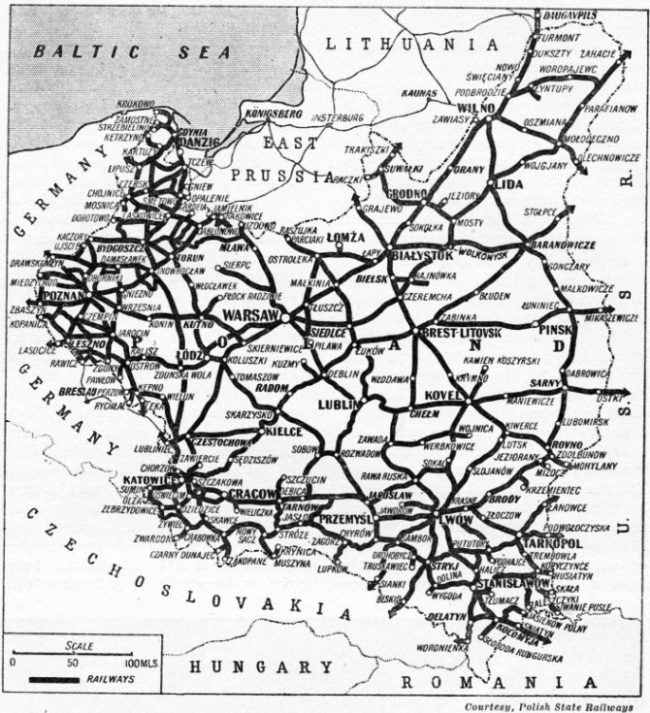
POLISH MAIN LINES are shown in this railway map. There are some 11,500 miles of track in Poland, and Warsaw is the main centre. Another 850 miles are planned for the near future The extension will cost £20,000,000.
After having left Warsaw, the train proceeds to Sochaczew (32½ miles away), a town of some 7,000 inhabitants, situated on the River Bzura. This was the Russian-
Lowicz (fifty miles), a town with 16,000 inhabitants, is a junction for Lodz and Skierniewice. Lowicz was formerly the residence of the Archbishops of Gniezno, primates of Poland. Before the partition of Poland the town was famous for its horse fairs and for the manufacture of weapons. The two Baroque towers of the collegiate church dominate the town. The church is rich in artistic and historic monuments, and contains the tombs of twelve primates. The beautiful national costumes worn by the peasants are to be seen and admired on Sundays and feast days. The women wear bright woollen skirts woven on their hand looms, and the sight of the peasants in procession on the feast of Corpus Christi attracts crowds of visitors.
Kutno (eighty-
Poland’s Oldest Town
Returning to the main line at Kutno we proceed to Kolo (114 miles), one of the most beautiful of the smaller towns, situated on the River Warta. The train then passes on to Konin. From this town a narrow-
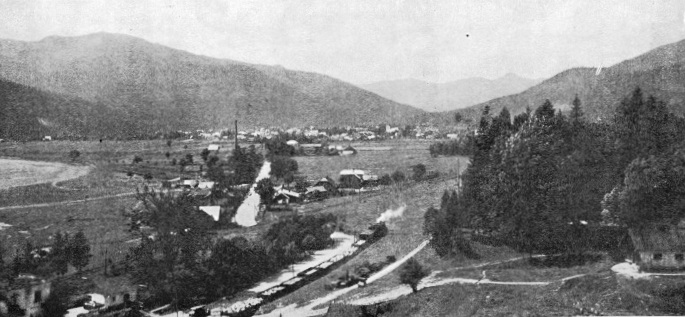
IN THE CARPATHIANS. The mountains of the Polish Carpathians provide excellent winter sport, and there are express services to many of the main resorts. The railway centre of the Western Carpathians is Cracow.
From Konin the train passes the former Russian-
Poznan (Posen in German) is the oldest town in Poland. It was the capital of the country in the tenth century. The Tartars destroyed the city in 1241, but it was rebuilt in 1257. In 1656 and in 1704 it was plundered and burnt by the Swedes and Prussians, and remained in a neglected condition for a long time. In 1793, after the second partition of Poland, it was occupied by the Prussians. The town was united by the Treaty of Tilsit with the Grand Duchy of Warsaw from 1806 to 1815, when it was restored to Prussia. From 1815 to 1918 it remained Prussian. In the nineteenth century Poznan was the chief centre of the Polish national movement in Prussian Poland.
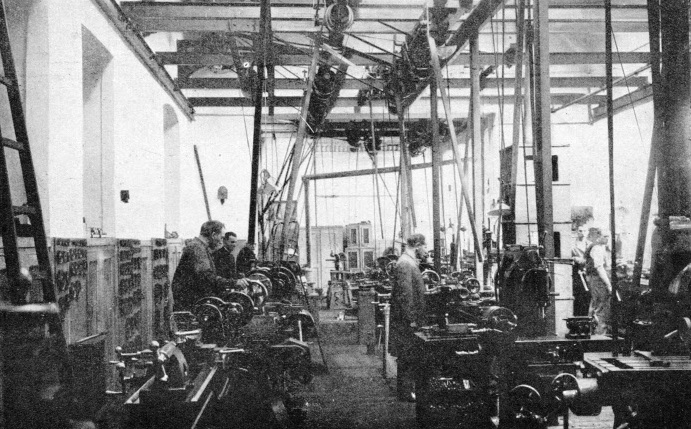
A TOOL SHOP AT WARSAW. In the early years of independence Poland purchased railway equipment from abroad. To-
After the failure of the insurrection of 1831, the Germans began to remove the Poles from official positions, and forbade the language to be spoken in schools. After the Franco-
From Poznan the railway proceeds another twenty-
The route from Warsaw to Poznan, by way of Lodz, is 239 miles long. Before entering Zielkowice (fifty miles), a suburb of Lowicz, the train follows the former route. It then goes on to Zgierz (eighty miles), the first town in the province of Lodz, and, after Lodz, the second centre of the wool industry. Lodz (eighty-
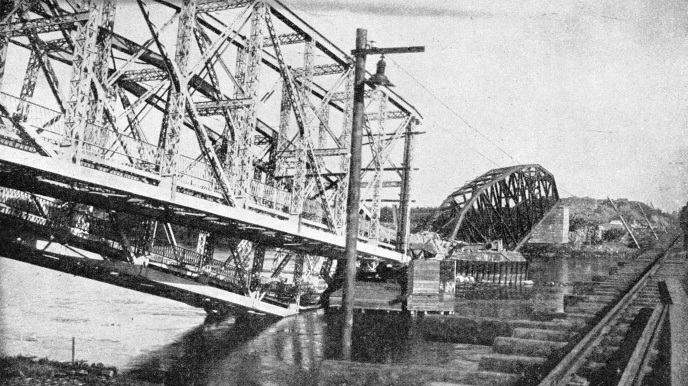
DEVASTATED BY WAR. A large railway bridge across the Memel (Niemen) River destroyed during the war of 1914-
To-
Early Difficulties
Lodz is the capital of the province of that name, but, despite its prosperity and its population, it is ranked among the second-
As recently as 1930 the town erected a monument to Tadeusz Kosciuszko, the Polish patriot who fought for the United States in the War of Independence and directed the last resistance to the partition of his country.
Pabjanice (ninety-
Kalisz (157 miles), with 55,000 inhabitants, has roots deeper in history. It existed in the Roman epoch, was a city of note in the Middle Ages, but in the nineteenth century it fell into a decline for the very pertinent reason that there was no railway. It did not revive until a railway was constructed as late as 1905. Then it had the misfortune to be close to the Russian-
The route from Warsaw to Poznan by way of Torun is 234 miles long. It was formerly the main route between Warsaw and Poznan and the main railway connexion between Russian and German Poland. From Warsaw the train proceeds to Kutno (eighty-
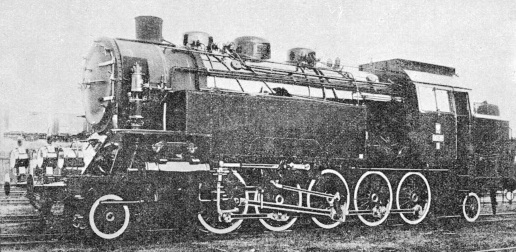
A PASSENGER TANK LOCOMOTIVE with a 2-
Wloclawek (117 miles), with 60,000 inhabitants, lies on the left bank of the River Vistula. The Bishop’s Palace, which was damaged by the Bolshevists in 1920, has been repaired. From Aleksandrow (140 miles), until 1914 the Russian frontier station, a local line runs nearly five miles north to Ciechocinek, the largest spa of central and northern Poland, the bathing establishment possessing about a dozen salt springs. These dozen iodine-
Torun (Thorn in German; 152 miles), with 60,000 inhabitants, the capital of the province of Pomorze, lies on the right bank of the River Vistula. A beautiful iron bridge, more than half a mile long, which was built in 1853, spans the river; a second bridge was begun in 1928. The famous astronomer, Copernicus, was born in the town in 1473. The campaign of the German Order of the Teutonic Knights against the Prussian heathens in 1230 began from Torun. As the chief centre of the corn trade -
Inowroclaw (167 miles) is a town from which a branch line runs south to Lake Gopio, near which is the small town of Kruszwica. On a small peninsula jutting out into the lake stands the Mice Tower of the fourteenth century, a relic of the castle of Casimir the Great, which was destroyed by the Swedes. According to a legend, Prince Popiel of Kujawy was eaten by mice in this tower.
The main line passes through the towns of Mogilno and Trzemeszno to Gniezno (202 miles), which has old monuments and modern factories, and then goes on to Poznan.
From Poznan an important line runs south to Rawicz, near the German border, where it connects with the line from Breslau. Mosina, which is twelve miles from Poznan on this line, is in an interesting locality. Nearby, at Rogalin, is the palace of Count Edward Raczynski, in which the French-
Leszno is connected by other lines with Jarocin, with Ostrow, and also with Zbaszyn; the network of railways has been closely constructed in this area.
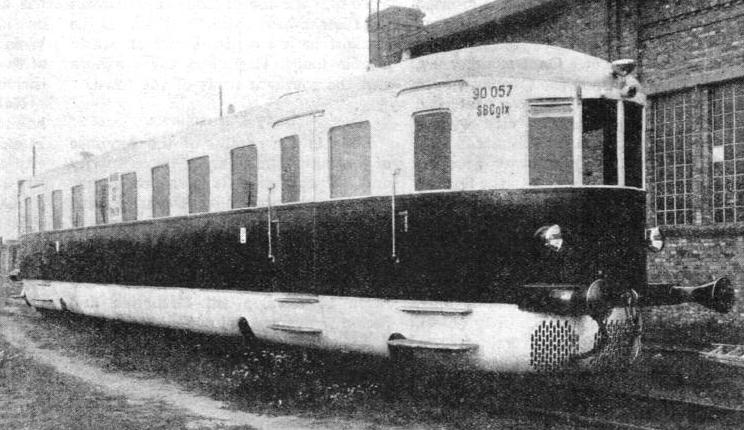
DIESEL-
From Poznan other lines run to Krzyz, in Germany, and towns near the border. The line linking Poznan with the new port of Gdynia runs chiefly across a region near the western border of the province, where practically no important towns are to be found. Beyond Kcynia the train passes extensive marshes, and crosses the River Notec before going north to the important junction of Chojnice (106 miles), a town of 12,000 inhabitants. It is a junction for lines to Berlin, Königsberg, and Laskowice.
Chojnice lies in a hollow between the hills, and has many historic buildings. The marshy ground which formerly surrounded it has been converted into meadows, but in the old days the marshes protected it to such good purpose that the Teutonic Knights held it for a long while in the Thirteen Years’ War. When the Poles captured it in 1466 it was the last Teutonic town west of the Vistula to surrender. Fragments of the old walls and several bastions still remain.
On leaving the town the train enters the district of Cashoubian Switzerland, called Zabory, meaning “beyond the large forests”. This district has a charm that attracts lovers of nature. Remains of the national Cashoubian culture are found in these remote parts. The small villages are inhabited by peasants of noble descent. The long, wide lakes among the pine forests are the haunt of many birds. Owing to the sandy soil the peasants are poor, fishing and farming being their only occupations. Most of the cottages are thatched and built of wood, and there are a number of beautiful old wooden churches. At Koscierzyna (148 miles) the train follows the route from Warsaw to Gdynia, which will now be described.
From Warsaw the train goes to Torun (146 miles), and then proceeds along the left bank of the Vistula for twenty-

LUXURY TRAINS IN POLAND are fitted not only with the usual amenities, but also with bathrooms such as that shown in this photograph taken on an express.
CONVERTIBLE COMPARTMENTS are in use on the Polish State Railways. During the night travel seats can be raised and the carriage then affords sleeping accommodation for four persons.
The town was founded in the fourteenth century, and was highly developed by the seventeenth century, but the Swedes almost destroyed it in 1656. After the partition great efforts were made to Germanize the town. But it has quickly regained its Polish character, and it is now the second town in the province of Poznan.
After leaving the town the train passes northward on a line which was built to reach Gdynia without passing through Danzig. From Maksymiljanowo (183 miles) to Czersk Pomorski (235 miles) the train crosses a thinly populated district with no large towns. The line runs through the forests of Tuchola, which extend from the River Vistula to the western border. The trees are mostly firs, growing in the sandy soil. There are many lakes and rapidly flowing rivers in the forests. Settlements and cultivated fields are now being made in what, before the building of the new railway, was virgin forest.
Emerging from the forest and going north, the train arrives at the town of Koscierzyna (248 miles) and enters Cashoubian Switzerland, with its wooded hills and lakes. Wiezyca (259 miles) lies at the foot of a hill which rises to the height of 1,086 ft above the sea, and is the highest in this area. A little beyond this station the new line turns to the east, leaving the old one, which goes to Kartuzy, the centre of Cashoubian Switzerland. This town of 5,000 inhabitants owes its name to the monastery of the Carthusians, which was closed by the Prussians in 1826.
There are no fewer than 173 lakes in this lovely district, which occupies the centre of the Polish Corridor. A local railway connects Kartuzy with Danzig. The train to Gdynia turns east and then north east, crosses the River Radunia, runs north, and, beyond Osowa (280 miles) it begins to descend from the Cashoubian upland towards the sea. In the distance can be seen the Baltic, and the port of Gdynia, 290 miles from Warsaw, is soon reached.
Another and shorter route of 255 miles from Warsaw to Gdynia is by way of Grudziadz and Tczew. From Warsaw the train runs along the eastern bank of the Vistula along the plain to Jablonna, and crosses the River Bug-
Historic Territory
Beyond Mlawa (eighty-
Grudziadz (163 miles), a town of 64,000 inhabitants, lies on the right bank of the Vistula, and is the second largest town in Pomorze. Formerly a fortified city, it existed as early as the tenth century. After the first partition of Poland, Frederick II made it a powerful fortress to safeguard the Prussian grip on the lower courses of the Vistula. In 1807, during the Napoleonic Wars, the French besieged it for several months, and it did not surrender until the Peace of Tilsit. The commander of the fortress. General Courbière, was called the “Lion of Graudenz”. He died and was buried in the fortress in 1811. The railway reached the town in 1878, and it became an industrial centre with an iron foundry and a factory for agricultural implements.
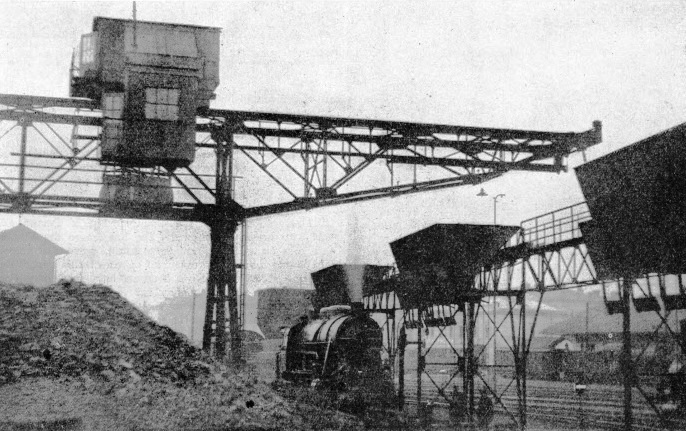
A POLISH COALING PLANT. Although the use of electricity as a source of power for trains in Poland has increased, steam still predominates. The Polish State Railways own nearly 6,000 locomotives.
The train crosses the Vistula by an iron bridge, 1,239 yards long, built in 1879. At Laskowice (176 miles) the train turns north for Tczew (222 miles), a town of 23,000 inhabitants on the Vistula, which here forms the boundary between Poland and Danzig. Five miles farther on the train crosses the border at just beyond Milobadz. On the left can be seen the hills of the eastern edge of the Cashoubian Switzerland, and on the right the fertile Danzig lowlands. After Danzig (242 miles) the train proceeds through the resort of Zoppot, regains Polish territory at Orlowo-
The Polish coast-
The territory of the Free City of Danzig has an area of 726 square miles and contains about 390,000 inhabitants. It is formed by the delta of the Vistula. The earliest mention of Danzig dates from 997, when it was the base of the missionary expedition of St. Adalbert, Archbishop of Prague, to the Prussian heathens. Until 1139 it was Polish; it then came into the possession of independent Pomeranian princes of the Gryfit dynasty. The last of these bequeathed the city to Poland. After a period of strife it was occupied by the Teutonic Knights in 1308. It became a free city in 1466, under Polish rule. In 1793 it was occupied by the Prussians. The French held the city from 1807 to 1814, and in 1815 it was annexed by the Prussians, who retained it until the end of the 1914-
The City of Warsaw
The hub of the railway system of Poland is Warsaw. The capital city, in the geographical heart of Europe, lies on the left bank of the Vistula, the great river which flows from the Carpathians to the Baltic. Some magnificent bridges span the Vistula at Warsaw. The city, which has 1,200,000 inhabitants, is linked by rail with many other European capitals. By railway London is twenty-
Founded in the thirteenth century, Warsaw became in 1595 the capital of the Kingdom of Poland. It is the centre of the administration, legislative and cultural life of the country as well as being a great manufacturing town. It is the junction for all the main lines.
Apart from its railway communications with the Baltic, the big industrial centre of Lodz, and the important city of Poznan and the connexions with Germany, there are many important lines radiating from Warsaw. One important route goes through Bialystok, a textile centre, and on north-
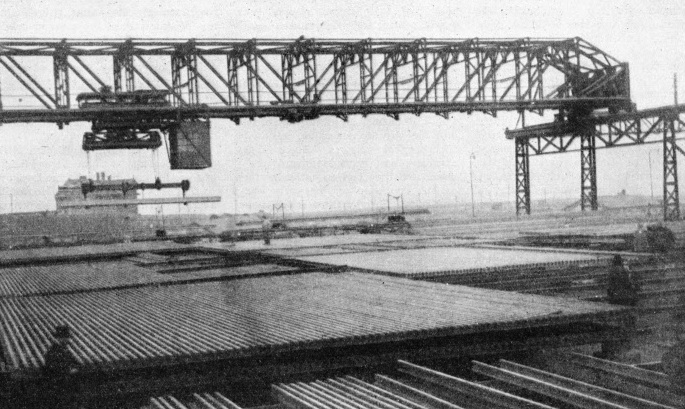
AN ELECTRO-
Cracow (Krakow), with a population of 232,000, is the capital of the province of that name, an ancient city and an important centre of arts and crafts. It lies on a railway which runs from Katowice (128,000 inhabitants), the capital of the province of Silesia, right across Poland through Tarnow (60,000 inhabitants) to Przemysl (60,000 inhabitants) on the San River. Przemysl became famous during the war as an Austrian fortress which withstood a long siege. This line goes on to Lwów, or Lemberg (316,000 inhabitants), where the railway station is the finest in Poland. Lwów was the capital of the Austrian province of Galicia, and after the reconstruction of Poland became the cultural centre of Eastern Galicia and also of the former Russian province of Volhynia. A network of railways extends in all directions from this fine city. Continuing east, a line goes to Tarnopol and the Russian border. The province of Tarnopol, known as Podolia, is dotted with ruins and historic monuments, and is very beautiful. The River Dniester has towering shores, covered with rocks or forests, and at one point flows through a canyon 650 ft deep. The district between this river and the River Zbrucz, which forms the Russian frontier, has a mild southern climate which favours vineyards, and the growing of apricots and similar fruit. Zaleszczyki, near the Romanian frontier on a branch line, is the centre of this region, and is also a popular summer resort.
The railway from Lwów to Warsaw passes the provincial capital of Lublin, a city of 100,000 inhabitants, on this line, fifty-
The Carpathian Mountains curve in a wide arch along the southern frontier of Poland, and summer resorts, spas, tourist centres and ski grounds are scattered over the mountains and valleys.
Stanislawów (80,000 inhabitants), the seat of a provincial government, on the railway from Lwów, is the starting point for excursions into the land of Hucules. The Hucules are a blend of Polish, Ruthenian and Romanian people, and are very conservative, preserving their ancient customs. Their homes, churches, and wayside crosses are of wood, and they find an outlet for their artistic talents in carving, embroidery, and rugs. Their country is the mountainous, wooded district between the rivers Czarna Bystrzyca, Prut and Czeremosz.
A Narrow-
A railway runs from Stanislawów to Woronienka, in the Prut Valley. The mountain resorts include Jaremcze, 1,700 ft; Mikliczynu, 1,960 ft; Tatarow, 2,200 ft, and Worochta 2,420 ft above sea-
West of this range an adjoining one, the Bieszczady Mountains, stretch from the Wyszkow Pass, the average height being 4,000 ft. Less wooded, they are more thickly populated, and can be reached by railway from Lwów and other centres. This district is popular with ski-
The long range of the Beskid Niski (Lower Beskids), with an average height of 2,500 ft, stretches west from Lupków. At the feet of the Bieszczady Mountains a string of spas and resorts has grown up. At Morszyn, on the railway between Stryj and Stanislawów, is a mineral bitter spring (sodium sulphite), the only one in Poland, and one of the strongest in Europe. The spa is a centre for mountain excursions. One of the largest spas in Poland is at Truskawiec, which is connected by railway with Lwów. Other spas are Rymanow, on the Nowy Zagórz-
The Carpathians rise to greater heights of from 3,600 to 4,000 ft, going west from the Tylicka Pass at Krynica. The most interesting part of this region is the district of the Pieniny Hills, which, forming a lateral spur, are not high but are very beautiful. The Dunajac River divides them into two regions and forms the frontier between Poland and Czechoslovakia. The highest point is Trzy Korony, 3,300 ft Nowy Targ, on the Cracow-
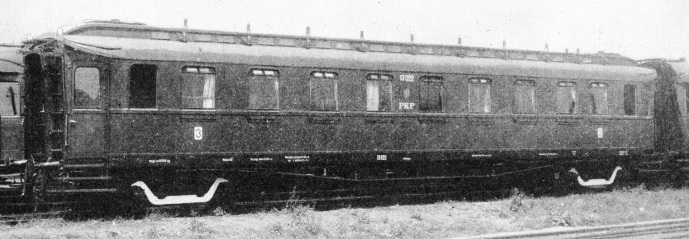
STEEL CARRIAGES have been introduced on the Polish State Railways. The photograph shows a third-
You can read more on “Electrification in Europe”, “Estonia and Lithuania” and
“In Central Europe” on this website.